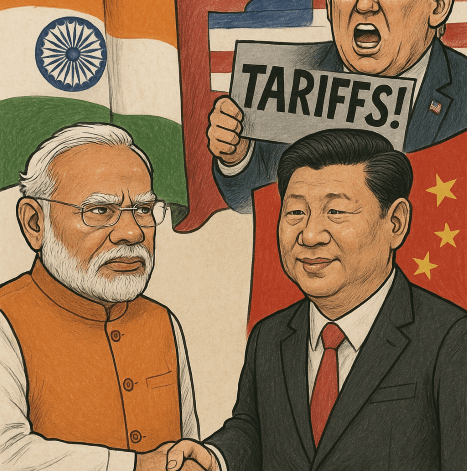India’s participation and Prime Minister Narendra Modi’s first visit in 8 yrs to China to Tianjin for the Shanghai Cooperation Organisation (SCO) summit has once again put the spotlight on the complex and layered relationship between India and China—a relationship that oscillates between cautious cooperation and deep-rooted mistrust. The SCO, designed as a regional grouping to promote security, connectivity, and economic cooperation among Eurasian powers, has increasingly become a platform where India and China engage despite their sharp strategic differences. Modi’s presence in Tianjin was therefore not just symbolic of India’s commitment to multilateralism, but also reflective of New Delhi’s cautious outreach to Beijing, even after episodes that have severely strained bilateral ties.
One of the most striking aspects of this visit was Prime Minister’s carefully measured tone toward Chinese leadership. While India has been critical of China’s aggressive stance at the Line of Actual Control (LAC), particularly after the Galwan clash of 2020 that claimed the lives of Indian soldiers, Modi avoided confrontation in Tianjin. Instead, he emphasized cooperation in trade, technology, and regional security in a way broadly reflecting New Delhi’s balancing act—acknowledging the risks posed by China, while recognizing the inevitability of engaging a neighbor that is both a rival and an indispensable regional player. For China, this outreach provides an opportunity to soften its image in South Asia, especially at a time when it faces global pushback from the US and its allies.
However, beneath the veneer of friendly overtures lies deep suspicion. India cannot ignore that Beijing continues to back Pakistan militarily and diplomatically, most recently during ‘Operation Sindoor,’ where China was accused of providing strategic support to Pakistan at a time when India was actively engaged in defending its security interests. India’s approach in Tianjin, therefore, is seen by many analysts as pragmatic diplomacy rather than genuine trust-building. India is well aware that China has repeatedly blocked its efforts to designate Pakistan-based terrorists at the UN, expanded military infrastructure near the LAC, and pushed forward with the Belt and Road Initiative (BRI), parts of which undermine India’s sovereignty in Jammu and Kashmir.
The second major takeaway from the summit was India’s effort to use the SCO platform to push its independent agenda. PM Modi highlighted issues of terrorism, regional stability, and connectivity, indirectly cautioning against China’s policy of shielding Pakistan while calling for collective responsibility in combating cross-border terrorism. Though the remarks were not pointed directly at Beijing, the subtext was unmistakable. By leveraging multilateral forums, India seeks to counterbalance Chinese dominance, while also ensuring that its voice resonates in Central Asia, a region where Beijing’s influence has grown rapidly.
Third, Modi’s visit highlighted the love-hate dynamics that have come to define India-China relations. On the one hand, both countries share massive trade volumes, cultural exchanges, and a seat at multilateral tables like the BRICS and SCO, which compel them to cooperate. On the other, trust deficit remains high due to repeated border standoffs and Beijing’s willingness to undercut India’s strategic interests. The Tianjin summit was an attempt to manage these contradictions, offering a temporary truce in rhetoric without addressing the core disputes that continue to fester.
Another important dimension is India’s larger foreign policy strategy. India’s China outreach must also be viewed through the prism of India’s simultaneous deepening of ties with the United States, Japan, and Australia under the Quad framework. By engaging China at the SCO while bolstering security partnerships with the West, India aims to maintain strategic flexibility. This dual-track approach allows India to avoid being cornered and ensures it can play a decisive role in shaping the evolving Asian order.
The summit also underscored Beijing’s attempt to project itself as a responsible leader within Eurasia, while India used the opportunity to assert its presence in the same space. This parallel quest for influence is bound to create friction, but it also makes sustained dialogue inevitable. India’s gestures of friendliness, therefore, should not be mistaken for a shift in India’s strategic posture. They represent a tactical necessity—keeping channels open, while preparing for possible confrontation.
In essence, Prime Minister’s visit is the reaffirmation of the delicate balance that defines India-China relations. Modi’s friendly overtures do not erase the memory of Galwan or China’s ongoing support for Pakistan. They just highlight India’s pragmatic recognition that geopolitics at the end of the day is that dialogue and deterrence must go hand in hand. For the foreseeable future, the India-China relationship will remain one of uneasy coexistence: cooperating on global platforms when necessary, but bracing for rivalry where interests fundamentally clash. This love-hate dynamic was on full display in Tianjin, and it will continue to shape Asia’s geopolitics in the years to come.

